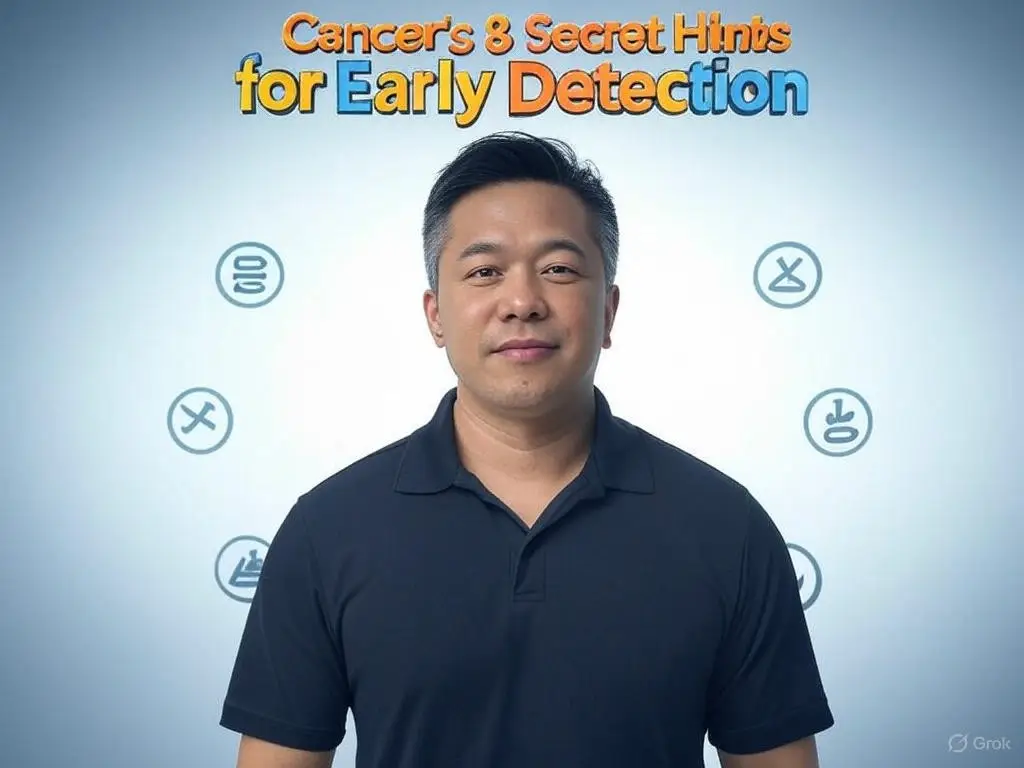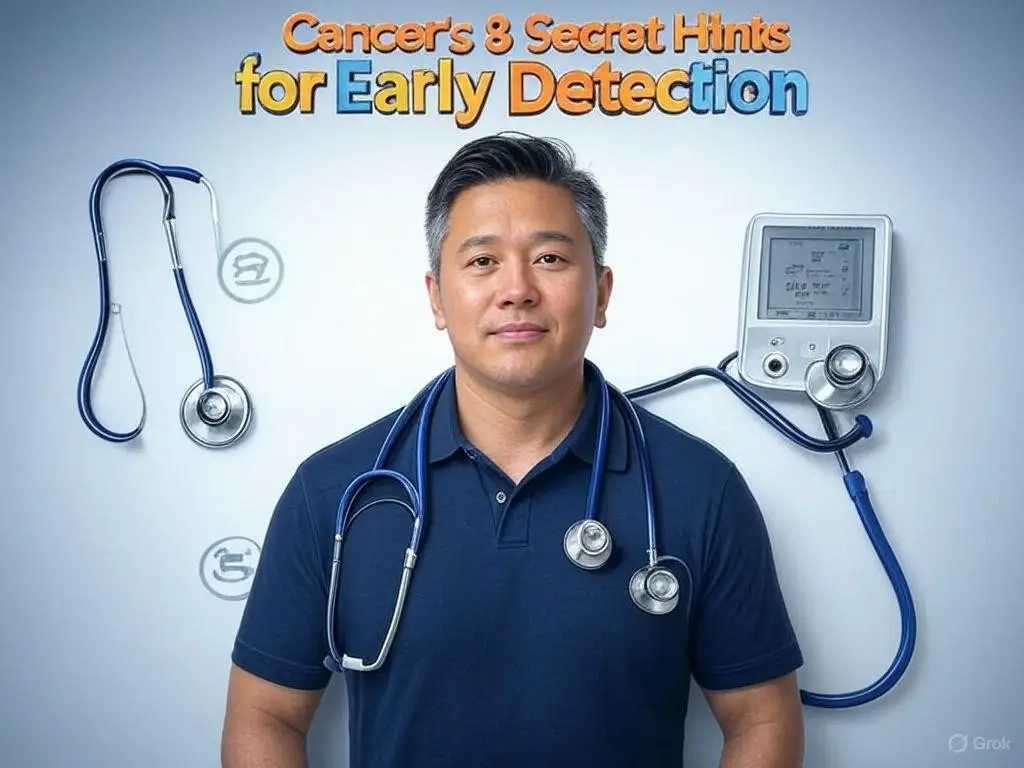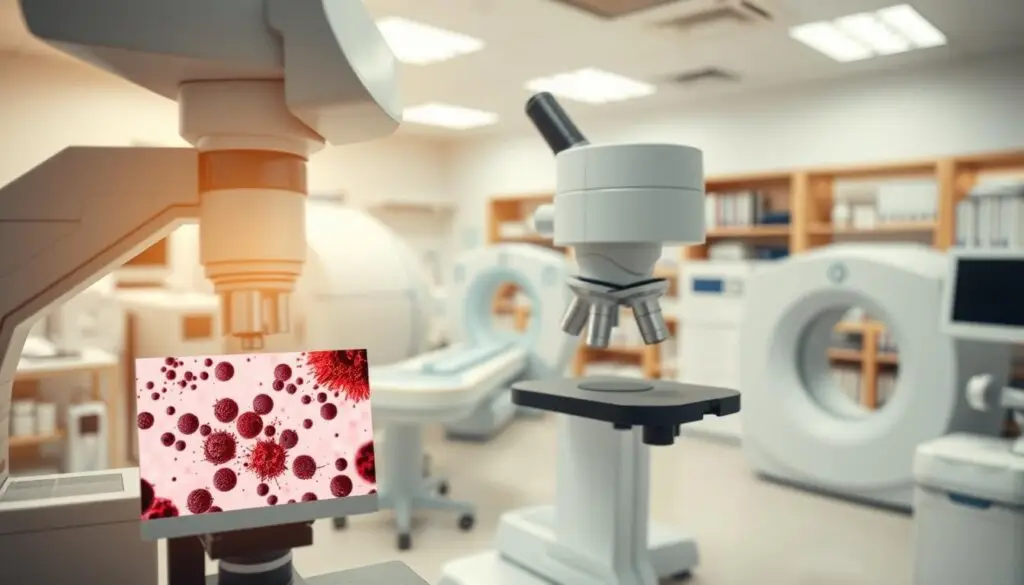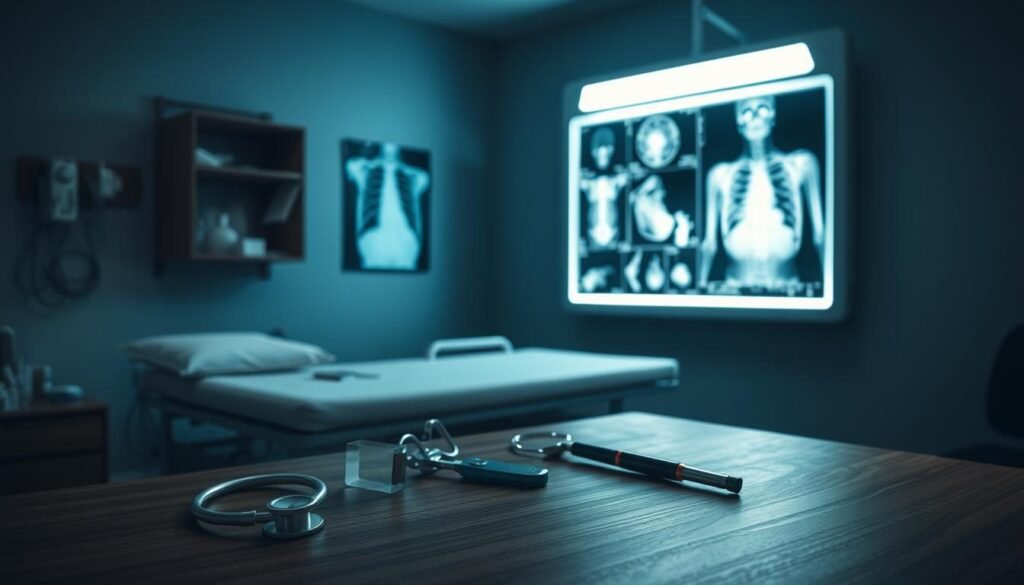“Cancer can hide—learn 8 secret hints to spot cancer early and empower your health with swift action for a stronger future.”

Table of Contents

Every year, thousands of lives are saved by catching it early. Knowing the early symptoms that are often missed can change everything. This guide shows 8 important signs your body might give you.
Being aware of cancer’s presence in your body can be lifesaving. Regular check-ups and understanding your body’s signals can significantly boost your chances of catching cancer early.
Many forms of cancer can be managed successfully if detected early. Stay vigilant about any changes that could signal cancer.
Early detection can lead to better treatment and more chances of survival. Yet, many people overlook these subtle signs. By learning to spot it early, you can take charge of your health.
Understanding cancer’s impact on your body is vital for early detection and treatment.
The National Institute says finding it early can boost treatment success by up to 90%. Your body sends out signals, like unexplained weight loss or changes in skin moles. This article makes these signs easy to understand and act on.
Key Takeaways
- Early detection improves survival rates by identifying it before it spreads
- Eight common but often overlooked symptoms are explained in simple terms
- Actionable steps to monitor your health and recognize warning signs
- Understanding how to differentiate between common issues and potential red flags
- Guidance on when to seek professional medical evaluation promptly
Understanding the Importance of Early Detection
Remember that early detection is key in battling cancer and improving survival rates.
Finding it early can change treatment results. Conditions caught early often respond well to treatments. This gives you more options and hope.
Early detection lets doctors target tumors before they spread. This reduces the need for harsh treatments like big surgeries or chemotherapy.
Catching cancer at an earlier stage can make all the difference in treatment success.

Addressing cancer symptoms promptly can lead to quicker diagnoses and better outcomes. Don’t wait to see if subtle changes resolve themselves, as they could indicate cancer.
Why Timing Matters in Treatment Outcomes
Learn to identify signs that may indicate cancer to improve your chances of early diagnosis.
Be proactive in monitoring any signs that could relate to cancer; being informed can save your life.
It goes through stages, each making treatment harder. In stage 1, tumors are small, making removal or radiation effective. By stage 4, it has spread, making treatment less likely to work.
For example, early-stage colon has a 90% 5-year survival rate. But, this drops to 14% when diagnosed late.
The Survival Rate Difference in Early vs. Late Detection
- Breast: 99% 5-year survival rate when detected early (stage 1) vs. 28% at stage 4.
- Lung: 63% survival rate in early stages vs. 7% in late stages.
Monitor your body for signs of cancer, as early detection can lead to more effective treatments.
The American Society’s data shows these big differences. Finding it early gives your body a better chance.
Breaking Down Barriers to Early Diagnosis
Awareness of cancer signs and symptoms is a major step toward achieving better health outcomes.
Many don’t use diagnosis tips because of fear or not knowing symptoms. People often delay because they think symptoms are minor. Lack of access to screenings and wrong information also play a part.
Regular check-ups and knowing your body’s changes are key steps. They help you stay ahead of it.
Don’t let fear keep you from seeking help and understanding cancer’s signs.
“Early detection isn’t just about medicine—it’s about empowering yourself with knowledge,” says Dr. Emily Carter, a leading oncologist.
Take charge by getting routine screenings, tracking symptoms, and talking to your doctor about risks. Small actions today could save your life tomorrow.
The Silent Nature: Why Symptoms Often Go Unnoticed
Its earliest symptoms are often very quiet. Many silent signs and symptoms start so subtly they seem like normal complaints. By the time cells start to multiply, the body might adjust, hiding signs until growth affects normal functions.

Early tumors might not cause pain or visible changes. Cells can hide by looking like normal tissue or growing slowly. Your body might adjust to small changes, hiding symptoms until they become more obvious. Fatigue, aches, or changes in digestion might seem like stress or aging, not warning signs.
- Early growths avoid triggering pain receptors.
- Symptoms like fatigue mirror common issues like sleep deprivation.
- Denial or normalization of symptoms delays action.
Recognizing symptoms requires being very alert. Persistent changes—like unexplained weight loss or a persistent cough—need attention, even if they seem minor. Screening guidelines help find these signs early. Listen to your body’s signals and make sure to get regular check-ups to catch it early.
Common Symptoms You Should Never Ignore
Spotting warning signs early is key. Four symptoms that don’t go away may mean you need to see a doctor fast.

Unexplained Weight Loss and Appetite Changes
Shedding 10+ pounds without trying is a warning sign. Feeling full quickly or losing your appetite can hint at conditions like those in the pancreas, stomach, or colon. These symptoms start slowly but get worse over time.
- Unintentional weight loss over 1–2 months
- Loss of appetite with abdominal discomfort
Persistent Fatigue That Rest Doesn’t Resolve
Feeling tired all the time, even after sleeping? This is fatigue related to serious conditions. It lasts longer than usual tiredness. If rest or changes in your lifestyle don’t help, see a doctor. This sign often shows up in blood-related issues.
Unusual Pain That Doesn’t Go Away
Pain that sticks around for weeks, like headaches or backaches, might mean tumors. Cramps or chest pain that won’t go away need attention. Sudden nerve pain or pressure could mean it’s advanced.
Changes in Bowel or Bladder Habits
Be on the lookout for:
- Blood in stool or urine
- Diarrhea or constipation lasting over 2 weeks
- Painful urination or sudden incontinence
These symptoms could be linked to conditions of the colon, bladder, or prostate. Keep an eye on changes in your stool or urine color.
Skin Changes as Potential Warning Signs
Unusual skin changes can be early symptoms worth checking. Look for persistent rashes, unexplained hair growth, or dark patches. These signs may signal issues like pancreatic or lung conditions before other symptoms appear.
Follow the ABCDE rule to spot it early:
- Asymmetry: One half doesn’t match the other
- Border: Jagged or blurred edges
- Color: Uneven shades of brown, black, or red
- Diameter: Larger than a pencil eraser
- Evolution: Changes in size, shape, or elevation
Jaundice—yellowing skin or eyes—may indicate liver or pancreatic symptoms. Clubbed fingertips, where nails curve around swollen tissue, can link to lung or digestive issues. Even hyperpigmentation on the palms or soles might signal hidden tumors.
Perform monthly skin checks. Use a mirror to examine hard-to-see areas. Note sudden texture shifts like hardening or swelling. If changes persist beyond two weeks, consult a dermatologist. Early detection saves lives—don’t dismiss subtle shifts in your skin’s appearance.
“Skin is a mirror of internal health. Any persistent change deserves evaluation,” says Dr. Emily Carter, MD, a dermatological specialist at Mayo Clinic.
Protect yourself: Avoid tanning beds, use broad-spectrum SPF 30+, and track moles with apps like SkinVision. Knowledge and vigilance are your best tools against its silent progression.
When Respiratory Issues Could Signal Something More Serious
Changes in breathing that last a long time might be warning signs. If you have a cough that won’t go away, keep getting sick, or see blood in your mucus, it’s time to act. Catching it early is key to better treatment—here’s how to recognize these signs.
Persistent Cough and Shortness of Breath
A cough that lasts over three weeks is a warning sign. It’s different from allergies or colds because it doesn’t make much phlegm. If you find it hard to breathe while doing simple things like walking, it could be a sign of serious issues.
Notice if your symptoms get worse over time, not just in a few days.
Recurring Bronchitis or Pneumonia
Getting sick in your airways often might mean something’s blocking them. Tumors can cause this blockage, leading to infections. If you’ve had bronchitis or pneumonia twice in a year, even if you’ve never smoked, see a doctor.
Non-smokers with these symptoms should get checked for warning signs too.
Coughing Up Blood: When to Act Now
Seeing blood in your sputum, even a little, is an emergency. Get help right away if you notice pink or dark spots in your mucus. Even a small amount could mean tumors in your airways.
Doctors might use CT scans or bronchoscopies to find out what’s causing it. Don’t think it’s just a minor problem.
Digestive Symptoms That May Indicate Serious Conditions
Changes in digestion can be silent signs and symptoms that need attention. Pain in the belly that lasts more than two weeks could mean stomach, pancreas, or colon issues. Bloating or nausea without a clear reason are also warning signs to talk about with your doctor.
“Digestive issues often present vague symptoms, making awareness critical for detecting it early,” advises the American Society.
- Difficulty swallowing (dysphagia): It gets harder to swallow, first with solids, then liquids, which might mean esophageal or throat issues.
- Stool changes: Narrow stools, black or tarry stools, or blood (bright red or dark) could indicate colorectal tumors.
- Jaundice: Yellow skin or eyes may signal liver, pancreatic, or bile duct problems.
- Early satiety: Feeling full quickly during meals might relate to stomach or pancreatic malignancies.
| Symptom | Possible Indications | Action Step |
|---|---|---|
| Persistent bloating | Ovarian, stomach, or colon issues | Schedule a colonoscopy or imaging scan |
| Unexplained weight loss | Pancreatic or stomach conditions | Consult a specialist within 2 weeks |
| Abdominal swelling | Liver or gastrointestinal tumors | Request a blood test and ultrasound |
If symptoms last more than two weeks or get worse, get help right away. Screenings like colonoscopies or imaging can help. Listen to your body—don’t ignore any unusual signs.
Recognizing Symptoms in Different Body Systems
Early symptoms can vary widely depending on where the issues start. Knowing signs specific to different body systems helps in recognizing symptoms sooner. Regular checkups and self-exams are critical for early detection.
Head and Neck Warning Signs
Persistent issues in the head or neck deserve attention. Look for:
- A sore throat lasting over 2 weeks
- Hoarseness or voice changes without cold/flu
- Unhealed mouth sores or white/red patches
- Swelling or lumps in the neck, jaw, or mouth
Breast Changes Beyond Lumps
Breast symptoms may include:
- Skin dimpling or puckering
- Nipple inversion, discharge (except during pregnancy), or scaliness
- Asymmetry in breast shape or size
- Redness or thickening of the skin
Reproductive System Warning Signals
Changes in reproductive health may signal deeper issues:
Being informed about cancer can empower you to take charge of your health.
- Unusual vaginal bleeding (post-menopause or between periods)
- Pelvic pain or pressure
- Difficulty urinating or blood in urine (men)
- Testicular swelling, heaviness, or hardness
Blood Disorders and Lymphatic System Changes
Monitor these hematologic signs:
- Unexplained bruises or frequent nosebleeds
- Recurring infections or fevers
- Swollen lymph nodes lasting more than 2 weeks
- Night sweats without exertion or illness
| Body System | Key Signs |
|---|---|
| Head/Neck | Long-term sore throat, voice changes, mouth sores |
| Breast | Skin dimpling, nipple changes, asymmetry |
| Reproductive | Abnormal bleeding, pelvic pain, testicular changes |
| Blood/Lymph | Unusual bruising, swollen nodes, persistent fevers |
Age and Gender: How Signs Vary Across Demographics
Knowing your age and gender helps spot symptoms early. It’s about understanding how risks change with age and across different groups. Your health history and family background are crucial for personalized tips.
Symptoms like rectal bleeding might mean colon issues in those over 50. But, it’s less common in the young. Always see a doctor for sudden changes. Age-based screening guidelines are important to know.
- Women often see thyroid symptoms more than men. Lung issues in nonsmoking women need extra attention.
- Men over 50 face higher prostate risks. Look out for urinary or pelvic discomfort.
- African American individuals should get colorectal screenings early due to higher rates.
Genetic factors like BRCA mutations in Ashkenazi Jewish people or Lynch syndrome in some families are key. Your doctor can assess your risk based on your background. Early diagnosis tips include tracking symptoms and family history.
No two people face the same risks. Be proactive by talking about your demographics with your doctor. Small health changes, linked to your age or gender, could be early signs.
The Role of Regular Screening in Helping Spot Issues Early
Regular screenings and self-checks are key to finding it early. This is when treatment works best. By knowing symptoms and doing screenings, you can protect your health. This increases your chances of early detection.
Recommended Screening Schedules by Age and Risk Factors
Health groups like the CDC and American Society give clear advice:
- Mammograms start at 40–50, based on risk
- Colonoscopies start at 45 for most adults
- Pap tests for cervical screening every 3–5 years
- Lung scans for high-risk smokers
Personal risk factors, like family history or genetics, might need earlier or more tests. Talk to your doctor to make a plan that fits you.
Self-Examinations You Can Perform at Home
Simple checks at home can help detecting it early:
- Breast: Do monthly exams, looking for lumps or texture changes
- Testicular: Check for swelling or hard masses monthly
- Skin: Use the ABCDE method to check mole changes
- Oral: Look for sores or white patches in your mouth
Keep track of what you find and tell your healthcare provider about any changes right away.
Modern Screening Technologies Making Early Detection Easier
Modern tools help spot it early through:
- Liquid biopsies find tumor DNA in blood
- AI-enhanced imaging for precise scans
- Genetic tests for inherited risk markers
These tools make tests less invasive and more accurate. But, always talk to your provider to avoid too much testing.
When to Consult Your Doctor: Creating an Action Plan
Knowing when to see a doctor is crucial. If you lose weight without trying or have pain that lasts 2–3 weeks, make an appointment. Signs that affect your daily life or get worse need to be checked out to spot it early.
“Listen to your body. Persistent changes are worth evaluating, even if they seem minor,” says Dr. Emily Carter, a preventive care specialist.
Here’s how to get ready for your doctor’s visit:
- Keep a symptom journal: Record dates, how long symptoms last, and what makes them better or worse.
- Write down questions: Ask, “Could this mean something serious?” or “What tests can rule out serious conditions?”
- Bring your family health history: This is especially important for conditions like breast or colon.
| Action | What to Do | Example |
|---|---|---|
| Urgent symptoms | Go to ER for sudden bleeding, severe pain, or trouble breathing | Coughing blood or sudden lumps |
| Non-urgent but persistent signs | Schedule a primary care visit within 1–2 weeks | Unexplained fatigue lasting over two weeks |
Don’t wait to see a doctor because you’re scared or ashamed. Many symptoms can be treated, but only a doctor can confirm. Early detection depends on quick action—act when you see red flags that match your risk.
Distinguishing Between Symptoms and Common Ailments
It’s important to know the difference between symptoms and everyday health issues. Many signs can look similar to minor conditions, but some patterns are more serious. Here’s how to figure out what you’re feeling:
Duration and Progression: Key Differentiating Factors
Time is crucial. A cold’s cough usually goes away in days. But, a cough that lasts for weeks is a sign to pay attention. Keep a journal of your symptoms. See if they get worse instead of better.
Combining Symptoms: When Multiple Signs Appear Together
Timely recognition of cancer symptoms can lead to more effective treatment plans.
| Common Ailment | Possible Serious Link |
|---|---|
| Sore throat (1-2 weeks) | Months of hoarseness + unexplained weight loss |
| Occasional constipation | Weeks of bowel changes + fatigue |
These symptoms alone might seem minor. But together, they could be a warning sign. Always talk to a doctor if you notice a pattern.
Risk Assessment: Your Personal Health Blueprint
- Family history: Certain syndromes increase risks
- Lifestyle factors: Smoking, obesity, or prolonged sun exposure
- Previous conditions: Chronic inflammation or prior radiation exposure
“A single symptom rarely confirms serious issues, but persistent patterns with risk factors require evaluation.” — American Society
Use these diagnosis tips to guide your actions, not scare you. Share your health history and symptom timeline with your doctor. This will help them give you the right advice.
Conclusion: Empowering Yourself Through Knowledge and Vigilance
Spotting issues early starts with knowing the warning signs. Look out for sudden weight loss, persistent fatigue, or changes in skin or digestion. These signs are not minor; they could be early warnings.
Early detection saves lives. It turns big threats into smaller ones with quick action.
Knowledge is your first line of defense. Knowing these symptoms doesn’t mean living in fear. It means staying alert. Follow screening advice, track body changes, and talk openly with doctors.
Regular self-exams and honest talks about family history help. They guide you to care ahead of time.
Today’s medicine helps find issues early. New imaging, genetic tests, and check-ups make early action possible. Take charge by getting tests and staying informed. Your watchfulness today could lead to better health tomorrow.
FAQ
What are the early signs I should be aware of?
Early signs include unexplained weight loss and persistent fatigue. You might also notice unusual pain or changes in bowel or bladder habits. It’s key to know your body and spot these symptoms early.
How can I spot issues early?
Be vigilant about any changes in your body that could be signs of cancer and seek medical advice.
Spotting issues early means being alert to silent signs. Regular self-exams and monitoring changes are crucial. Also, don’t forget to keep up with screenings.
Ultimately, your health is in your hands; understanding cancer is a vital part of that.
Why is early detection important?
Early detection leads to better treatment options and survival rates. It often means less invasive treatments and a better prognosis than later diagnoses.
What should I do if I notice symptoms that concern me?
If you notice warning signs, see your healthcare provider quickly. Keeping a symptom journal can help your doctor evaluate your situation.
Are all symptoms obvious?
No, many signs are subtle and can be mistaken for other conditions. It’s crucial to take any health changes seriously, even if they seem minor.
How can I differentiate between symptoms and common ailments?
Look at how long your symptoms last and if they get worse. Symptoms often don’t go away and can get worse. If symptoms cluster or you have a family history, see a doctor.
What are some tips for discussing symptoms with my doctor?
Timely intervention is crucial in the fight against cancer; early detection can save lives.
Be clear and concise when talking to your doctor about symptoms. Keep a symptom journal to note when symptoms started, how long they last, and what makes them worse. This helps your doctor understand your concerns and may lead to further evaluation.
How do age and gender affect symptoms?
Symptoms can differ by age and gender due to biological reasons and common conditions in certain groups. Knowing these differences can help you recognize symptoms early and get medical help quickly.
Regular check-ups can help catch any cancer early on, increasing your chances for successful treatment.
Educating yourself about cancer can lead to timely discussions with your healthcare team.
Awareness of cancer and its symptoms can lead to proactive health management.
Share this content:
